Find Peace At The Timeless Beauty of Buddha Stupa Nepal In 2026
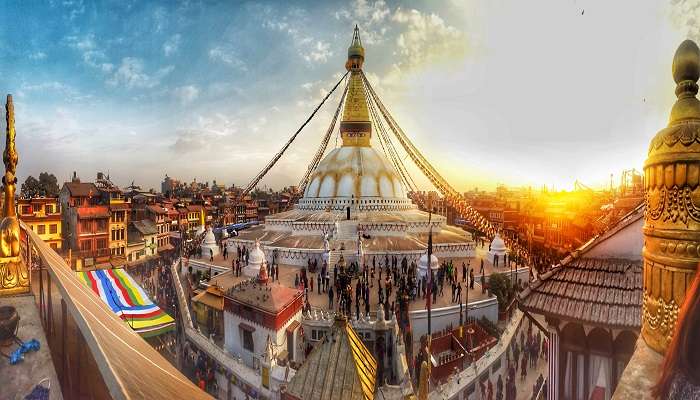
Buddha Stupa Nepal, also known as Boudhanath, is a revered Buddhist pilgrimage attracting visitors worldwide. Being a part of the UNESCO World Heritage Site, the stupa is one of the largest in the world and has a unique octagonal design. An aerial view of the stupa displays its geometrical beauty and a striking view when the sun shines over its gold spire. With beautifully drawn Buddha’s eyes on the stupa and the tranquil surroundings, you would find yourself lost in its beauty. It centres on religion, culture and devotion, bringing people together.
Boudhanath Stupa Nepal History
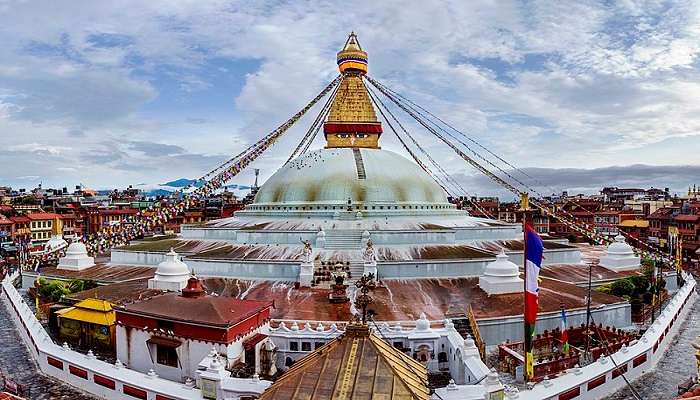
The Boudhanath stupa of Kathmandu is one of the latest spherical stupas in the world. Although there have been no written records about its date of construction, it is estimated to be present from the 3rd century. It is one of Nepal’s most important Buddhist pilgrimage sites, and the interior is sealed. The stupa contains inscriptions and remnants from Gautam Buddha’s body. The structure of the stupa is filled with symbolism; each part relates to the life cycle of a human. This UNESCO World Heritage site suffered major damage due to the 2015 earthquake. With the efforts of the private and government entities, the stupa has been repaired significantly.
Must Read: Places To Visit Near Kathmandu
Boudhanath Stupa Architecture
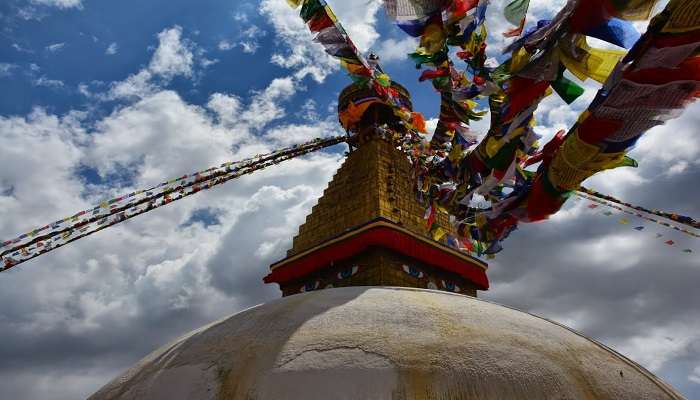
Buddhist stupas in Nepal, such as the iconic Boudhanath, have a deep meaning in enlightening visitors to walk on the correct path. Read on to understand each symbol, one of the top reasons for visiting the Boudhanath stupa. Here is a detailed description of the architecture of the Buddha Stupa:
- The stupas stand at a height of 118 feet. There are no other structures in the vicinity to compare to its glory.
- The stupa is built on an octagonal base, signifying the eightfold path of life. Several octagonal platforms lead to the white structure.
- Around the base of the stupa, prayer wheels spin while repeating the chants and prayers. Devotees come from far and wide to circumambulate around the stupa clockwise while praying and rotating these wheels.
- The entrance of the stupa is adorned with 108 stone figurines of Buddha.
- There are several colourful flags at the top of the stupa. Each flag has mantras for success and prosperity written on it. These represent air
- Two spherical bowl-like structures support the stupa’s structure. These symbolise water and represent the vastness of the universe.
- A vivid illustration of Buddha’s eyes is present on all four sides of the stupa. These eyes symbolise that Buddha is watching over them.
- The top of the dome has a pyramid of thirteen steps, each decreasing in size as it goes up. This symbolises the journey of enlightenment.
- At the top of the pyramid stands a gold spire with a five-coloured flag. It is believed that this flag carries the prayers of the devotees to heaven.
Legend Of Buddha Stupa Nepal
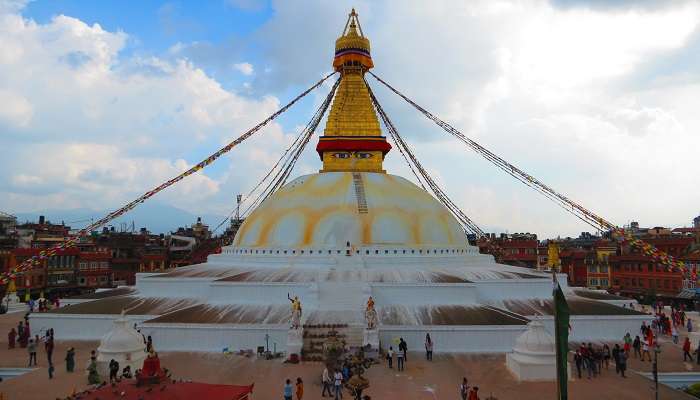
Various stories are linked to the establishment of this stupa, which has been passed from one generation to another, but there are slight variations in the story. According to the Tibetan Buddhist script, it was established by one of the daughters of God Indra. She had once stolen flowers from heaven, and because of that, she was punished and reincarnated. She came to earth as the daughter of a poultry man and struggled throughout her life. She courageously faced all problems and built the stupa with her wealth. The king mocked her and gave her land equal to the area of the hide of a buffalo. She stitched the buffalo’s skin to cover a massive area to build the stupa. Her bravery and wit led to the establishment of the Boudhanath stupa.
Suggested Read: Waterfalls In Nepal
Buddha Stupa Nepal Entrance Fee
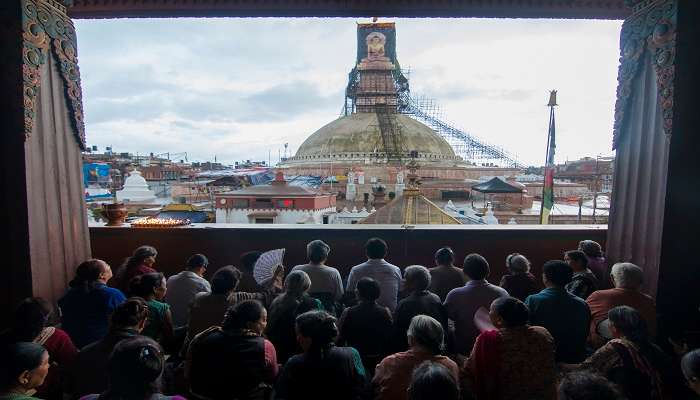
The Buddha Stupa Nepal remains open day and night for the ones seeking guidance and peace. The entrance fees are different for visitors from different nationalities. Here is a detailed structure of the entrance fees:
- Nepalese citizens: Free
- SAARC nationals: NPR 100
- Foreigners: NPR 1000
- Children below the age of 10 (any nationality): Free
Places To Visit Near Buddha Stupa Nepal
After exploring the Buddha Stupa in Nepal, you can enhance your day by visiting these nearby attractions. Just a short distance from the stupa, here are our top recommendations. Each site offers a unique experience and will make your trip more memorable.
1. Garden of Dreams
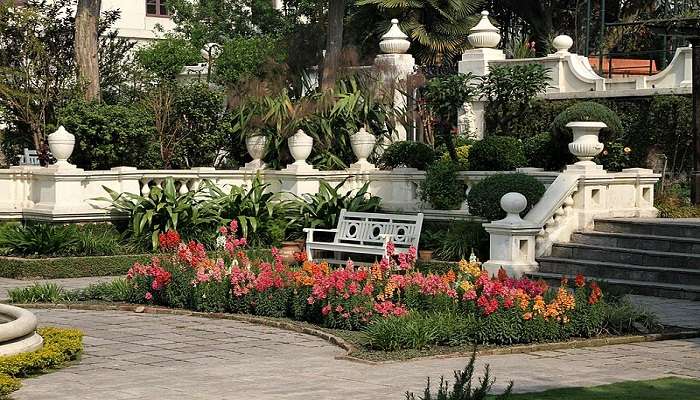
Located 5 km from Buddha Stupa Nepal, Garden of Dreams is a massic garden spread over 6900 square metres. It is also known as the Six Season Garden of Dreams, which represents the different seasons of Nepal. Built by field marshal Kaiser Sumer Shah Rana, the garden has walking paths, ponds, flower beds, an amphitheatre and a Kaiser cafe for visitors. The garden has a sophisticated Edwardian style that is perfect for a stroll. Both tourists and locals visit this place to refresh their minds and enjoy the beauty of exotic plants and flowers. The garden is also a hub of shows and cultural performances.
Timings: 9 am to 10 pm
Entry Fee: NPR 150 for local residents and NPR 400 for foreign tourists
Suggested Read: Nepal Temples
2. Chandragiri Hills
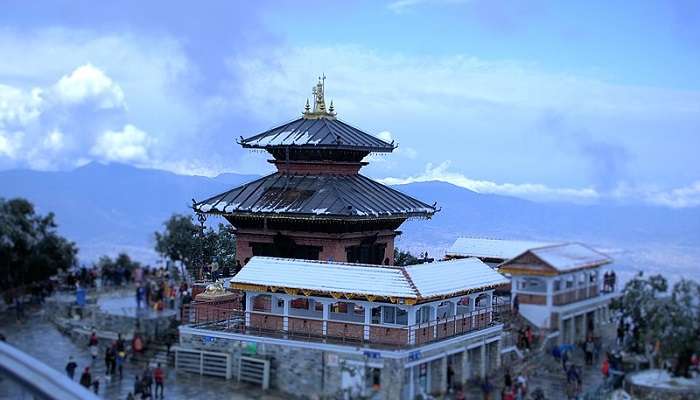
Located 30 km from Buddha Stupa Nepal, Chandragiri Hills is the perfect hill station escapade. It is located at a height of 2551 metres; this majestic hilltop gives the most breathtaking views of the Himalayan mountain range. You can see the Annapurna Hills, Everest mountains, and many other mountains as you travel on this hill, the longest cable car ride in Asia. Enjoy the lush green mountain and seek blessings from the Bhaleshwar Mahadev temple at the top. With multiple restaurants and vendors on the way, you can trek on this hill to experience nature’s beauty.
Timings: 9 am to 6 pm
Entry Fee: NPR 415 for local residents, USD 9 for Chinese tourists, and USD 13 for foreign tourists
3. Nyatapola Temple
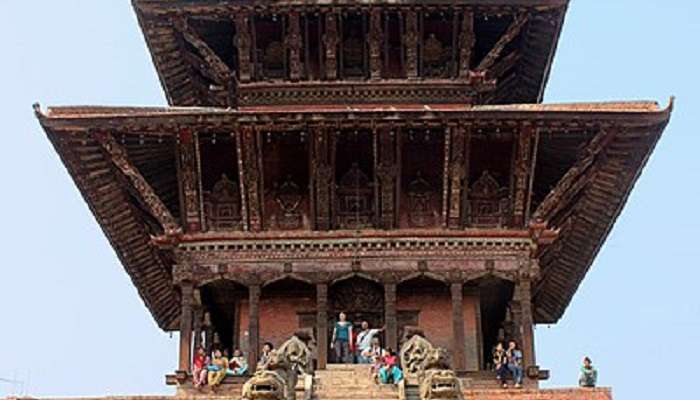
Located 9 km from Buddha stupa Nepal, Nyatapola temple is a rich heritage temple in the Bhaktapur Durbar square. It is a five-storey temple racing 98 feet in the air, each floor symbolising the elements of nature. It was constructed in the Newari architectural style in wood and stone with a solid foundation, which withstood the 2015 earthquake as well. Enjoy the fragrance and chants in this temple of goddess Siddhi Lakshmi. The temple is typical for locals, and there are several shops, hotels, and vendors nearby that you can visit to explore the culture of the people.
Timings: Open 24 hours
Entry Fee: Free for the local residents, NPR 500 for SAARC and Chinese Nationals, NPR 1500 for foreign tourists
Suggested Read: Shopping In Nepal
4. Hanuman Dhoka
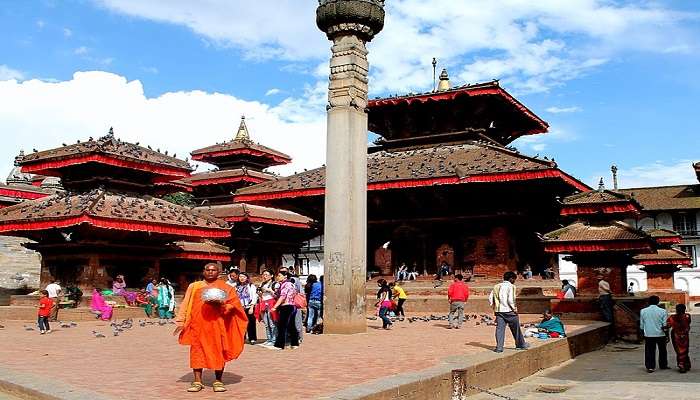
Located 7 km from Boudhanath stupa, Hanuman Dhoka is a magnificent structure that attracts tourists to the square. It was a royal palace with multiple temples, courtyards, museums, and palaces. It comprises Mul Chowk (the central courtyard), Basantapur Durbar, and Hanuman Dhoka Palace. With its legacy dating back to the 4th century, each structure displays ancient wooden works, stone carvings, and statues from Hindu mythology. Even after the earthquake damage, most of the Durbar square remains undamaged.
Timings: 9 am to 5 pm
Entry Fee: Free for the local residents, NPR 150 for SAARC Citizens, NPR 750 for Chinese and foreign tourists
Further Read: Tourist Places In Nepal
The alluring beauty of Buddha Stupa Nepal attracts visitors from all over the world. Despite the damages, the entire community united to bring back its glory. Come and experience the peace at the Buddha Stupa. If this guide about Buddha Stupa Nepal motivates you, here are some of the best packages for a trip to Kathmandu. The region, being the centre of religious and natural beauty, will not disappoint you.
For our editorial codes of conduct and copyright disclaimer, please click here.
Cover Image Source: Bijay Chaurasia for Wikipedia
Frequently Asked Questions About Buddha Stupa Nepal
How much time is required for a tour of Buddha Stupa Nepal?
Three to four hours is enough time to experience the beauty of Buddha Stupa Nepal. If you have spare time, you can explore the nearby places to make the most of your day.
What is the best time to visit Buddha Stupa Nepal?
The best time to visit Buddha Stupa Nepal is early morning or evening. In the morning, you will experience the daily rituals of the monks.
What to wear when visiting Buddha Stupa Nepal?
When visiting the Buddha Stupa, it is important to wear clothes covering the shoulders and knees. Adhere to decent clothes to show respect to the stupa.
What are some festivals I can experience in Buddha Stupa Nepal?
The Buddha Stupa shines enthusiastically and vibrance on Buddha Jayanti and Tibetan New Year. The stupa brings everyone to celebrate and enjoy the festival with special rituals and prayers.
Is photography allowed in the Buddha Stupa Nepal?
Yes, photos are allowed in the temple area. However, be mindful and ask the monks' permission before photographing them.
People Also Read:
Dhauli Shanti Stupa Dhamek Stupa Sanchi Stupa

Get ready to wander the world through amazing visual tours that we provide via our blogs and stories. As a content writer, I love sharing incredible travel experiences that inspire readers to plan their own adventures and create unforgettable memories. From planning to execution, everything has already been served in these amusing tales. Let’s explore the world together, one destination at a time!











